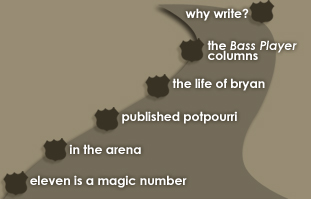
 |
|||||||||
|
|
|||||||||
| Sign up for BellerBytes, the official (and private) Bryan Beller e-newsletter. Just click here to sign up. Do it, OK? | |||||||||
|
"Basso
Ja Kitara-Kimpassa Kiemuroita" [BB's Note: Confused by the above credits? I wrote this article on my computer before The Big Virus of Late 1996, which wiped out my entire hard drive, including the original version of this article. Since I seem to have lost my hard copy of it as well, the original English is gone forever. My man in Finland, Jaan Wessman, re-translated it for me, and I think the result is very interesting. I've kept his "version" of it mostly intact, with some slight editing for grammar's sake. Thanks, Jaan!] Greetings! I'm Bryan Beller, the bass player for Mike Keneally's Beer For Dolphins. Every so often with Keneally I have to: (a) play what at first seem like impossible licks; (b) reharmonize unusual motifs; and (c) play simultaneously in a different time signature than him. How does this all happen? Are there shortcuts to success in these instances? In the following examples, I will tell you about my experiences with unusual kinds of teamwork between a guitarist and a bass player. Ex. 1: "Impossible" Licks Most bass players have confronted a situation where a guitarist asks the bassist to play a fancy lick in unison with him (usually to get the audience to go wild). The difficulty lies in that hard licks like these call for too many position changes for the bass; the overall result sounds clumsy. You cringe because the fret spaces on your bass are wider than on the guitar. (Who said the bass was easier to play than the guitar?) Sometimes you simply have to break the rules and use open strings. My first example is a lick from a Keneally tune called "Lightnin' Roy" (hat, (c) 1993 Spen Music, BMI), which you literally can't play cleanly without utilizing open strings. (Click HERE for a picture of Musical Example #1.) Those who are not used to such a thing might think this is a little weird. I can assure you though that, most of the time, this trick saves you from many unwanted problems.
Ex. 2: Reharmonization Besides just doubling licks, the guitarist may ask you to compose something (behind a riff) which thoroughly changes the character of the music. This is called "reharmonizing" -- instead of playing the root note of the chord, you play something different which might end up changing the quality of the chord completely. It is important to choose this procedure at the right moment in time. My second example ("Sweating In School" from Half Alive In Hollywood, (c) 1996 Spen Music, BMI) is all about reharmonization. The riff of this tune is repeated several times. It's a complicated C-sharp blues lick that is fun to play a couple of times in unison. But to make things interesting, play the bass lines of the following examples. This example will be best if you can find a guitarist to play the main riff with you, and have him repeat his figure as written so you can hear the different things that happen when reharmonization is done correctly. (Click HERE for a picture of Musical Example #2.) Ex. 3: Superimposed Time Signatures How can you synchronize the inner clocks of the guitarist and the bassist and make them both tick together.when they are ticking at different rates? The case of this next example is a time signature on top of another different one. The bass player plays in 5/8 against the guitar player's 3/4 as shown in the third example below ("Skunk" from Boil That Dust Speck, (c) 1994 Spen Music, BMI). (Click HERE for a picture of Musical Example #3.) As you can see, the time signature on the bass staff is not 5/8-and that's the whole trick. The bass player plays in a 5/8 "feel" and lands on the mutual "one" with the guitar player at the right time. This becomes possible by adding four notes to the fourth bar of the example. They've been added to the end of the 5/8 sequence so that the next musical phrase (four bars for both the guitarist and the bass player) will begin at the same time. The bass line sounds easier than it looks, because notating the line in 3/4, even though it's in a 5/8 "feel," appears a bit odd on the page. When you catch the drift, satisfaction will be guaranteed. You may have to tap your foot on the floor for hours on end in order to keep the flow going, and it sure helps to avoid listening to the guitar and the vocals too closely while you get up to speed. Other than that, this is merely an exercise in counting. So, from over here in the Los Angeles heat, I hope you stay warm with these examples. You have it dark and cold over there. [Translator's note: No shit... :-)] (Click HERE for a picture of how this article appeared when it ran in the August, 1996 issue of Rytmi.) |

|